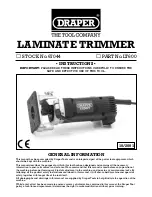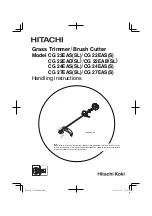
26
GB
the site and decide which cutting height you require.
Guide and hold the line spool at the required height to
obtain an even cut. Fig. 43
Low trimming
Hold the trimmer right in front of you at a slight angle so
that the underside of the line spool is above the ground
and the line strikes the correct target. Always cut away
from yourself. Never draw the trimmer towards yourself.
Cutting along fences/foundations
Approach wire mesh fences, lath fences, natural stone
walls and foundations slowly so that you can cut close
to them without striking the obstacle with the line. If,
for example, the line strikes stones, stone walls or
foundations, it will wear or fray. If the line strikes wire
fencing, it will break.
Trimming around trees
When trimming around tree trunks, approach slowly so
that the line does not strike the bark. Walk around the
tree, cutting from left to right. Approach grass or weeds
with the tip of the line and tilt the line spool forwards
slightly.
Warning! Take extreme care during mowing work. When
doing such work keep a distance of 30 meters between
yourself and other people or animals.
Mowing
When mowing, you want to cut all the vegetation down
to the ground. To do this, set the line spool at an angle
of 30° to the right. Place the handle in the required
position. Remember the increased risk of injury to the
user, watchers and animals, and the danger of damaging
property due to objects (for example stones) being
thrown.
Warning!
Do not use the equipment to remove objects
from footpaths, etc. The equipment is a powerful tool and
can throw small stones and other objects a distance of
15 meters or more, causing injuries and damage to cars,
houses and windows.
Jamming
If the cutting blade jams as a result of attempting to
cut vegetation that is too dense, switch off the engine
immediately. Remove the grass and scrub from the
equipment before you restart it. Fig. 42
Preventing recoil
When you work with the blade, there is a risk of recoil if
it strikes solid objects such as tree trunks, branches, tree
stumps, stones or the like. This will throw the equipment
backwards in the direction opposite to the rotation of the
tool. This can cause you to lose control of the equipment.
Do not use the blade near fences, metal posts, boundary
stones or foundations.
10. Maintenance
Before performing any maintenance or cleaning work,
always turn off the engine and pull out the spark boot
plug
.
1. Do not spray the unit with water. It damages the
engine.
2. Clean the unit with a cloth, hand brush, etc.
Maintenance schedule
12 hours of
use
24 hours of
use
36 hours of
use
Air filter
clean
clean
replace
Spark plug
check
clean
replace
Expert inspection is required:
• If the brush cutter strikes an object.
• If the motor stops suddenly
• If the blade is bent (do not align!)
• If the gears are damaged.
Replacing the line spool/cutting line Fig. 35 - 39
1. Dismantle the line spool (1) as described in section
8.4 Assembly. Press the spool together and remove
one half of the housing. Fig. 35
2. Take the spool plate out of the line spool housing.
Fig. 36
3. Remove any remaining cutting line.
4. Place the new cutting line in the center and hang the
loop which has formed into the recess in the spool
splitter. Fig. 37
5. Wind the line onto the spool counter-clockwise and
under tension. The spool splitter will separate the two
halves of the line. Fig. 38
6. Hook the last 15cm of the two ends of the line onto
the opposite lying line holders of the spool plate. Fig.
39
7. Thread the two ends of the line through the metal
eyelets in the line spool housing .
8. Press the spool plate into the line spool housing.
Fig. 36
9. Pull the two line ends sharply to release them from
the line holders.
10. Join the housing parts together again. Fig. 35
11. Cut the excess line to a length of around 13cm. This
will reduce the load on the engine when starting and
warming up.
12. Remount the line spool (see section 8.4). If you are
replacing the complete line spool, skip points 3-6.
Grinding the safety hood blade
The safety hood blade can become blunt over time.
• When you notice this, undo the screw holding the
safety hood blade on the safety hood.
• Clamp the blade in a vise.
•
Sharpen the blade with a fl at fi le and make sure
that the angle of the cutting edge is not altered in the
process. File in one direction only.
Summary of Contents for BCH3300-100PB
Page 2: ......
Page 3: ...3 18 23 19 20 21 22 4 5 6 2 17 2 1 7 a b c d 1 1 6 7 8 9 2 3 4 5 12 10 11 13 14 15 ...
Page 4: ...14 17 9 10 4 25 24 11 15 16 A 8 24 12 13 ...
Page 5: ...18 19 20 21 25 24 26 27 7 8 6 9 23 22 ...
Page 6: ...31 34 37 28 29 30 32 33 35 B C 36 ...
Page 7: ...WIND CORD 38 39 40 42 41 43 ...
Page 51: ......
Page 52: ...52 Ersatzteilzeichnung Spare parts drawing Pièces détachées dessin 33 33 3 ...
Page 53: ...53 3 ...
Page 55: ...55 ...
















































